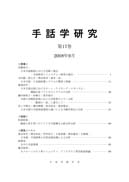I visited Taiwan on June 6-7, 2008 to present a paper on bilingual and bicultural education for deaf children in Japan at a seminar held at Tunghai University, Taichung. On that occasion, I had a chance to visit a school for the deaf in Taichung and an association of hearing impaired persons and their families. It was an excellent opportunity to observe the use of Taiwan Sign Language (TSL). Some salient characteristics of TSL are summarized below through comparisons with the situation in Japan. • At the National Taichung Special Education School for the Hearing Impaired, the signs used in classroom are Signed Standard Chinese, not the local natural sign • Certification of sign language interpreters started two years ago, and there is no professional association of sign language interpreters yet. • There is one sign language in Taiwan, with regional variations. Among the regional variations, the Taipei dialect is the most preferred. • The extended middle finger, which is more difficult to articulate, is used more frequently in TSL than in Japanese Sign Language (JSL). TSL also retains the use Comparative studies of the two sign languages would be interesting from a historical point of view in establishing that older forms tend to be retained on the periphery. language, that is, Taiwan Sign Language. The use of Signed Standard Chinese is encouraged to reflect the Chinese grammar more accurately and is viewed as a more acceptable “standard.” of the ring finger, as in /SISTER/, which is now articulated with the pinky in JSL. It seems that the shift is toward easier handshapes. In TSL the handshapes using the middle finger seem to be still productive, while they are fading from use in JSL. I visited Taiwan on June 6-7, 2008 to present a paper on bilingual and bicultural education for deaf children in Japan at a seminar held at Tunghai University, Taichung. On that occasion, I had a chance to visit a school for the deaf in Taichung and an association of hearing impaired persons and their families. It was an excellent opportunity to observe the use of Taiwan Sign Language (TSL). Some salient characteristics of TSL are summarized below through comparisons with the situation in Japan. • At the National Taichung Special Education School for the Hearing Impaired, the signs used in classroom are Signed Standard Chinese, not the local natural sign • Certification of sign language interpreters started two years ago, and there is no professional association of sign language interpreters yet. • There is one sign language in Taiwan, with regional variations. Among the regional variations, the Taipei dialect is the most preferred. • The extended middle finger, which is more difficult to articulate, is used more frequently in TSL than in Japanese Sign Language (JSL). TSL also retains the use Comparative studies of the two sign languages would be interesting from a historical point of view in establishing that older forms tend to be retained on the periphery. language, that is, Taiwan Sign Language. The use of Signed Standard Chinese is encouraged to reflect the Chinese grammar more accurately and is viewed as a more acceptable “standard.” of the ring finger, as in /SISTER/, which is now articulated with the pinky in JSL. It seems that the shift is toward easier handshapes. In TSL the handshapes using the middle finger seem to be still productive, while they are fading from use in JSL.Comparative studies of the two sign languages would be interesting from a historical point of view in establishing that older forms tend to be retained on the periphery.
View full abstract
